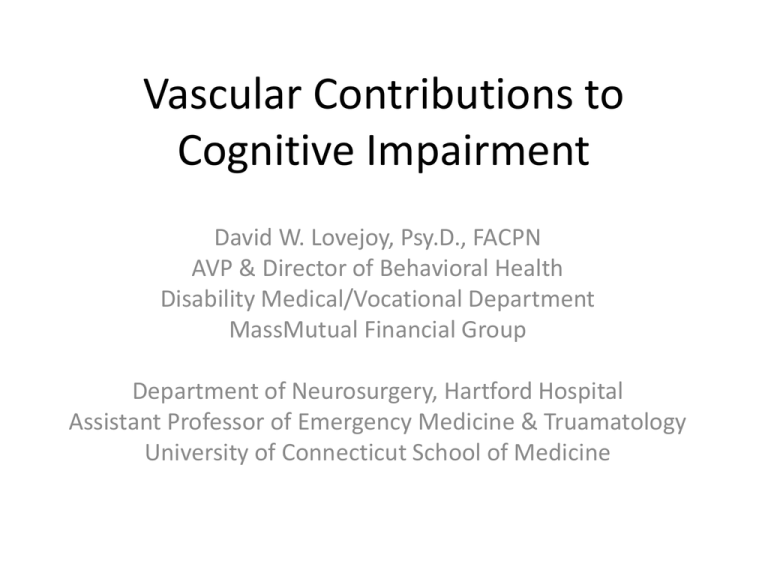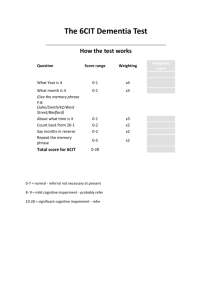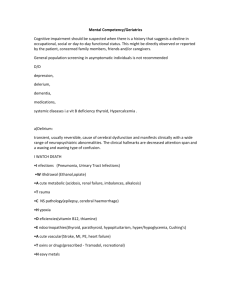Vascular Contributions to Cognitive Impairment
advertisement

Vascular Contributions to Cognitive Impairment David W. Lovejoy, Psy.D., FACPN AVP & Director of Behavioral Health Disability Medical/Vocational Department MassMutual Financial Group Department of Neurosurgery, Hartford Hospital Assistant Professor of Emergency Medicine & Truamatology University of Connecticut School of Medicine Agenda • Vascular changes in that impact brain structure and function (stroke & small vessel changes) • Cognitive changes in normal aging vs. pathological cognitive changes • The concept and spectrum of Vascular Cognitive Decline (VACD). • A little bit of neuroanatomy (I promise just a little) • The clinical manifestations of VACD. • The concept of Cognitive Reserve in understanding cognitive decline • Useful concepts for underwriting & claims Cerebrovascular Changes Zlokovic and Apuzzo, 1998 What is normal for older adults? • Normal cognitive aging – Reliable declines in processing speed – Influence performance in other domains including attention, memory, problem solving – Changes are considered to be mild, ageappropriate, and do not interfere with daily functioning • Instrumental activities of daily living (IADLs) • Occupation and leisure activity 5 Data from Seattle Longitudinal Study (Schaie, 2005); 6 Types of dementia Alzheimer's dementia (AD): 60% Vascular dementia (VaD): 15-20% Lewy Body dementia 10% Others including frontal lobe dementia, alcohol, CBG 10% • Expected that VaD will become the most common form of dementia throughout the world • Each for of dementia has its own stage of Mild Cognitive Impairment (MCI) • • • • Dementia syndrome (DSM) • Memory impairment • One or more of the following: – – – – Aphasia (problems with communication) Apraxia (problems with “overlearned” movements) Agnosia (problems recognizing faces/objects) Disturbance in executive functioning (planning, problem solving, anticipating outcomes) • Represent a decline from prior levels of function • Interfere with social/occupational functioning (IADLS & ADLS are typically impacted by the cognitive impairment) 8 Alternative guidelines • Memory criteria reflects an “Alzheimerization” of dementia • AD presents with early, severe memory impairment, other dementias may not • Alternative is impairment in multiple domains that impact daily function 9 Defining AD and VCI • A significant evolution in terminology of cognitive deficits associated with cerebrovascular disease (CVD) • MID: used to identify patients who developed dementia after multiple strokes • VCI: encompasses all cognitive disorders associated with CVD, from mild deficits to frank dementia • VaD: severe cognitive and functional impairment regardless of CVD etiology VCI Definition “A syndrome where there is evidence of clinical stroke or subclinical vascular brain injury and cognitive impairment affecting at least one cognitive domain.” . Vascular Cognitive Impairment Continuum Healthy Vascular Function Vascular At-Risk Risk Factors: Age Obesity Diabetes HTN Hypercholesterolemia CAD Smoking VCI VaD Presence of cerebrovascular disease accounts for about one third of the risk for Dementia of the Alzheimer’s Type Vascular Cognitive Impairment/Decline • Generally clinicians look for – Stepwise progression, prolonged plateaus or fluctuating course – Focal cognitive deficits but not necessarily memory impairment – Impaired executive function (difficulty problem solving, difficulty with judgement) • Diagnosis strengthened by – Focal neurological signs (weakness on one side, difficulty with speech) – Neuroimaging (CT or MRI) consistent with ischemia – CV risk factors, concurrent peripheral vascular disease, coronary artery disease etc Pathways to vascular cognitive impairment O’Brien (2006). Vascular cognitive impairment. Am J Ger Psyc, 14, 724-733. 14 Large Vessel Stroke Infarcts & Hemorrhages • Post-stroke dementia/ Multi-infarct dementia – Dementia developing after multiple completed infarcts – Significant proportion of pre and post-stroke dementia remains undiagnosed • Strategic stroke – Dementia developing after occlusion of a single large sized vessel in a functionally critical area • Large vessel strokes are the easiest to recognize. Often accompanied by motor, sensory and/or language changes. Temporal relationship between event and cognitive loss usually evident. Dorsal Vascular View Infarct: Tissue death casused by obstruction of blood supply. The term stenosis = narrowing Left MCA Infarct Left MCA Territory Infarct Predicting & Limitating of the Ischemic Penumbra & Antithrombotic Meds Hemorrhagic Stroke Dementia Following Stroke • Dementia Incidence estimates (3 months post CVA) vary: 25-41% • Most will suffer some form of cognitive impairment either temporary or permanent • Clinical features will depend largely on what part of the brain was damaged • Depression common • Location of stroke may be more important than how much tissue died (necrosis) Connectivity!!!! Small Vessel Disease • • • • • • • • • • White matter abnormalities White matter lesions White matter changes Small vessel disease Small vessel ischemic disease Microangiopathy Leukoariosis small infarcts T2 flair hyperintensities Silent strokes Small Vessel Disease Small vessel disease (SVD) or microangiopathy is mediated by risk factors such as hypertension and diabetes. Related to ischemic damage of varying degrees that has been caused by injury to the penetrating vessels that supply the basal ganglia, thalamus, putamen, caudate subcortical white matter and internal capsule. This is cerebrovascular disease Comparison of stroke & brain microvascular disease Characteristic Stroke (arterial) Microvascular disease (arteriolar) Onset/progression sudden/brief if any ill-defined/gradual over years Manifestations focal neurologic deficit functional impairment Location vascular distribution grow from head/taillateral ventricles Size stroke(cm)→lacune (mm) <1 mm Vessel large to small artery arteriolar Pathogenesis vascular disease risk factors vascular disease risk mechanism of tissue - ischemic factors - unclear damage Small Vessel Disease & Lenticulostriate Arteries (coronal image) LA on Magnetic Resonance Imaging Normal Mild Moderate Severe From Malloy et al, 2006 Pathology Originally it was suggested that selective demyelination might occur as a result of ‘‘incomplete’’ ischemia, but a single electron microscopy study showed that pallor was largely due to loss of nerve fibres in their entirety. Small Vessel Disease • • • • • • • Frontal lobe deficits Executive dysfunction Inattention Depressive mood changes Changes in gait Parkinsonism Memory impairment is often less pronounced – More sub-acute course WMH Changes with Age and Vascular Disease • WMH in the frontal lobe are present in healthy middle aged and elderly (? How healthy?) • WMH volume is related to vascular health • Over 5 years WMH loads increased: – 2.6% year in healthy adults – 9.6% year in adults with VD • Lesion load may not correlate with funtional Raz et al., Neuropsychology, 2007;21:49 (cognitive) impairment Location of Infarct/Cognitive Reserve? 23% of lacunar infarct patients developed dementia within four years, which represented a 4-12 fold increase in risk relative to controls. Many strokes considered silent. Loeb et al., Stroke, 1992; 29: 1225 Cerebral Infarctions and VCI • In clinical-pathologic studies, larger infarct volume and increased number of macroscopic infarcts are associated with an increased likelihood of dementia • There is yet no reliable cut-point for infarct volume and dementia • Infarct location is important: thalamus, angular gyrus and basal ganglia may be more likely than other regions to result in cognitive impairment • Microscopic infarcts have been related to dementia, even after accounting for macroscopic infarcts • Ischemic change is a risk factor for further ischemic change • Cognitive reserve and other co-existing pathologies may be additional factors when relating cerebral infarctions to cognitive impairment and dementia Practical Observation We don’t always see the cognitive impairment that we would expect given the amount of brain pathology present. The concept of Cognitive Reserve may help to explain inter-individual variability in the expression of cognitive impairment Cognitive Reserve • ReserveThreshold Summarized by Satz (1993) • Hypothetical construct: “Brain Reserve Capacity” (BRC) • Concrete examples of BRC: neuronal count • There is individual variation in BRC • Education and IQ are indices of BRC • There is a critical threshold of BRC. Once depleted past this critical point, specific clinical or functional deficits emerge. Adapted from Satz (1993) Brain Reserve Capacity Lesion Protective Lesion Functional Impairment Cutoff Factors Patient 1 Patient 2 AD combined with lacunar infarcts = more severe cog impairment earlier in AD course. Premorbid declines in reserve capacity & concept of Mixed Dementia. Data from Nun Study Mixed dementia • Vascular lesions appear to have a synergistic and/or additive effect with AD pathology • Presence of infarcts increases odds for clinical expression Dementia of Alzheimer’s Type • If evidence of cerebrovascular disease present, the density of plaques and tangles needed to cause dementia is lower than that needed for “pure AD” • Most persons with dementia and 50% of those with Alzheimer’s have CVD VCI Diagnostic Criteria: Vascular Mild Cognitive Impairment (vaMCI) 1. vaMCI includes the four subtypes proposed for the classification of MCI: Amnestic, Amnestic + other domains, Non-amnestic single domain, and Non-amnestic multiple domain. 2. The classification of vaMCI must be based on cognitive testing, and a minimum of 4 cognitive domains should be assessed: Executive/attention, memory, language, and visuospatial functions. The classification should be based on an assumption of decline in cognitive function from a prior baseline and impairment in at least one cognitive domain. 3. Instrumental activities of daily living could be normal or mildly impaired, independent of the presence of motor/sensory symptoms VCI Diagnostic Criteria: Dementia 1. The diagnosis of dementia should be based on a decline in cognitive function from a prior baseline and a deficit in performance in two or more cognitive domains that are of sufficient severity to affect the subjects’ activities of daily living 2. The diagnosis of dementia must be based on cognitive testing, and a minimum of 4 cognitive domains should be assessed: executive/attention, memory, language, and visuospatial functions. 3. The deficits in activities of daily living are independent of the motor/sensory sequelae of the vascular event. Neuropsychiatric Symptoms • The neuropsychiatric symptoms of VaD can be very different qualitatively, as those in AD • Patients with VaD have a higher risk for institutionalization than those with AD, partly because of BPSD (behavioral & psychological symptoms of dementia). • Present in mixed dementia • Executive dysfunction – poor planning and judgement, no anticipation of the consequences of actions • Abulia/Apathy – pervasive lack of initiative or drive • Disinhibition • Depression • These impairments arise later in pure Alzheimers course. Frontal lobe vs. temporal lobe for disease initiation. Summary • VCI is a syndrome that includes a broad range of cognitive impairment severity • Executive dysfunction is often, but not always included in the VCI cognitive impairment pattern • The most severe form of VCI is VaD • vaMCI includes individuals with cognitive impairment who do not meet dementia criteria • Keys to defining VCI are neuropsychological testing, bedside or office clinical examination and neuroimaging Summary • VaD is a common cause of dementia • Look for risk factors of VaD and focal neurological signs • Significant memory impairment is not always present • BPSD more common and can occur at earlier stage than AD – behavioral strategies are helpful Underwriting Considerations • Pay attention to subjective complaints • Consider age • Obtain Medical Records – – – – – – – MRI reports (report body and reason for referral) Consider location and extent of white matter lesions Consider size of lesions Consider presentation (punctate, linear, confluent) Pay attention to mention of atrophy Progression across MRI studies Consider comorbid vascular risk factors and their severity • Consider late life depression as a unique entity • Consider a cognitive screen, but be familiar with its strengths and weaknesses • Involve your medical resource Claims Considerations • Understand how the diagnosis was established. Imaging, diagnostic critertia • Collect information that informs about severity of cognitive impairment (MMSE, Neuropsych, family observations, treater observations, driving status, living situation, conservator of person or finances). • Understand the nature of the cognitive impairments and how they link to the inability to complete an ADL • Understand that the functional impairments may be driven by BPSD • Understand whether the condition is progressive or whether improvement may be possible. – Recovery from Stroke – Meds for BPSD • Consider an AP call. We often don’t understand • Involve your medical resource






